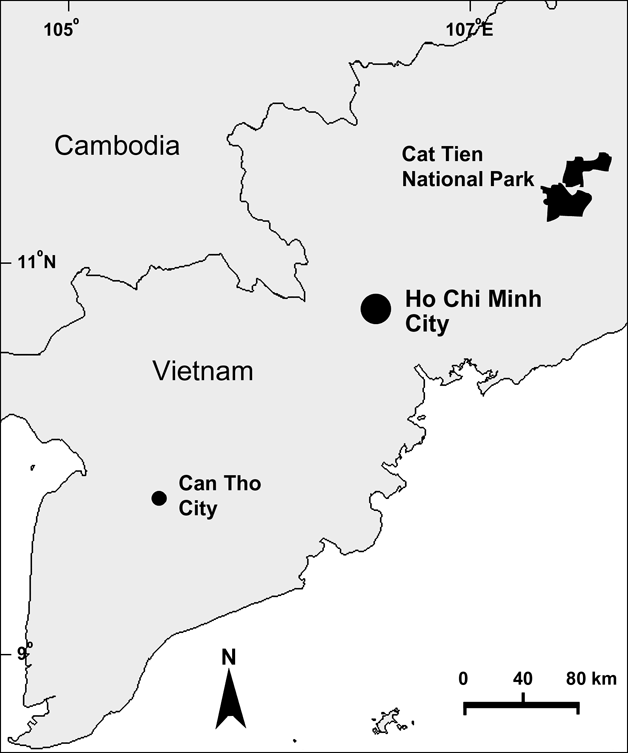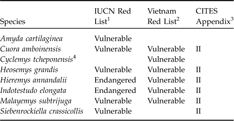Turtle populations around the world have declined drastically during the past 30 years (van Dijk et al., Reference van Dijk, Stuart and Rhodin2000). In Asia the main threats to turtles are the destruction and modification of natural habitats, and wildlife trade. While the former is considered the greatest threat to many species, current levels of turtle trade have a much greater impact (van Dijk et al., Reference van Dijk, Stuart and Rhodin2000; Ginsberg, Reference Ginsberg2002). Overexploitation of turtle populations in Asia to supply wildlife trade results primarily from an increasing demand in China where a long tradition of using turtles for food and medicine arises from the belief that turtles have a significant role in improving human health (Compton, Reference Compton, van Dijk, Stuart and Rhodin2000). Although the tradition has existed for centuries, the trade in turtles has grown at an unprecedented rate since the early 1990s because of demand from China's growing middle class and because the Chinese currency is now being readily converted to other currencies (Zhao, Reference Zhao and Devaux1995; Behler, Reference Behler and van Abbema1997). Turtle trade has also increased because of growth in the Malaysian and Thai economies as well as the opening up of markets in Vietnam, Laos and Cambodia after their long isolation (van Dijk et al., Reference van Dijk, Stuart and Rhodin2000).
The turtle fauna in Vietnam is especially threatened because of its geographical proximity to China. Although collecting wildlife species is illegal, Vietnam's traders exported 35.7 t of mostly wild turtles comprising 11 species to China and Taiwan during 1994-1999 (Nguyen, Reference Nguyen2003). The quantity of turtles used locally is insignificant, accounting for <10% of the harvest (Le & Broad, Reference Le and Broad1995; Hendrie, Reference Hendrie, van Dijk, Stuart and Rhodin2000).
Conservation efforts to date in Vietnam have focused on emergency measures such as the confiscation of illegally traded animals. To set appropriate priorities for conservation, data on population status, distribution, and trade patterns are required but the data available (Hendrie, Reference Hendrie, van Dijk, Stuart and Rhodin2000) are insufficient for this purpose. To address this problem a survey was conducted in Cat Tien National Park in southern Vietnam because the Park is relatively well protected and has been chosen as a site for the release of turtles (Turtle Conservation and Ecology Project, 2001). Turtle populations in many protected areas in the north may have already been extirpated (Kiester & Juvik, Reference Kiester and Juvik1997). The Park comprises a total area of 73,878 ha over three provinces, Dong Nai, Lam Dong, and Binh Phuoc (Fig. 1), and is home to 108 mammal, 339 bird, 123 reptile and amphibian, 130 fish, 439 butterfly species, and eight (Table 1) of the 24 species of terrestrial turtle known from Vietnam. It has permanent and seasonal wetlands that provide important habitat for both aquatic and semi-aquatic species.

Fig. 1 Map of Southern Vietnam showing the location of Cat Tien National Park.
Table 1 Turtle species in Cat Tien National Park, compiled from the checklist of reptiles and amphibians in Cat Tien National Park (G. Polet, pers. comm.), with their global and national Red List category and inclusion in a CITES Appendix.

I carried out diurnal and nocturnal surveys in Cat Tien National Park during 21 July-26 August and 10 October-1 November 2004, focusing on permanent and temporary wetland areas because most turtle species that occur in the region are aquatic or semi-aquatic (Ernst & Barbour, Reference Ernst and Barbour1989). In total 68 hours were spent searching for turtles. Surveys were more intensive in the Bau Sau Wetland Complex because this permanent wetland is a potentially important site for turtles. It contains well preserved habitat able to support large populations of both carnivorous and herbivorous species.
In the Bau Sau Wetland Complex I searched for breeding and feeding sites around the shore and in the lake, respectively. The latter were identified based on the unique vegetation pattern that remains after turtles have fed (Plate 1). Three funnel traps (Legler, Reference Legler1960) were set at two sites during 8-22 August and 10 October-1 November, and checked every 2 days. Captured turtles were photographed, sexed, aged (hatchling, juvenile, adult), measured (carapace length, plastron length and shell height), marked using Sharpie paint pens, to avoid double counting, and released. Information about trade and collecting activities was obtained through informal interviews with local traders, hunters, and forest guards.

Plate 1 A feeding site in Bau Sau Wetland Complex. Note the difference between natural vegetation with water primrose Ludwigia adscendens on the left and vegetation browsed by turtles on the right.
Six of the eight species known from the Park were observed (Table 2). No individuals of Indotestudo elongata were found in the wild, although a local trader had reportedly bought some I. elongata collected from the Park, and one confiscated turtle of this species was released in the Park during the time of my surveys. Softshell turtles Amyda cartilaginea were not surveyed because they are not under the same collecting pressure, being farmed throughout Vietnam (M. Le, pers. obs.). A total of 52 individual turtles were located, with 30 individuals of four species (Appendix) trapped in the Bau Sau Wetland Complex, where 12 turtle feeding sites but no breeding sites were found, one individual each of Heosemys grandis and Malayemys subtrijuga trapped in temporary wetlands and dry forests (Appendix), a total of 13 individuals of the six species for sale, and seven individuals of three species being kept as pets (Table 2). According to one local trader C. tcheponensis is the most commonly traded species. In addition, surveys in the Park in 2001-2004 recorded a large adult male of M. subtrijuga, two adults of H. grandis, an adult of Siebenrockiella crassicollis, and 12 Cyclemys tcheponensis representing all age classes from hatchlings to adults (W. van Devender, pers. comm.).
Table 2 Number of turtles observed in Cat Tien National Park in this survey, their price, and where they were found. Details of all turtles trapped are in the Appendix.

1 k, kept as pets by local people; s, for sale by traders; w, trapped and found in the wild
2 Although populations were not estimated, the number of captured S. crassicollis is particularly high given the short duration of the survey and the small size of the areas where traps were deployed.
This study shows that, although turtle populations in Vietnam have been heavily exploited since 1989, viable populations still appear to survive in Cat Tien National Park. These populations require protection because trade is still prevalent. The local trade surveys indicated that turtles are sold in a number of places around Cat Tien National Park. Malayan pangolin Manis javanica and Javan wart snake Acrochordus javanicus were also observed being traded at Phuong Lam Town and Dac Lua Village near the Park. From these locations wildlife probably enters the international trade with China or is sold domestically to urban areas, where eating wildlife is becoming common (Nguyen, Reference Nguyen2003; Polet & Ling, Reference Polet and Ling2004).
For the immediate future, increasing the effectiveness and level of investment in Park protection, including the coordination of law enforcement between policemen and forest guards, would help conserve these turtle species. Measures to control trade may not be effective because of the complexity of the trade network and limited government resources. Even if individuals for sale are confiscated, costs associated with rehabilitation and release are often high, and releases may introduce diseases to natural populations (Jacobson et al., Reference Jacobson, Brown, Schumacer, Collins, Harris and Klein1995). In addition, the release of turtles to their natural range may not be successful if regulations in the protected areas are not strictly enforced as the released turtles could be re-caught. For the long-term conservation of these species several measures must be taken simultaneously, including implementation of stricter laws, better enforcement, improved cooperation between the governments of Vietnam and China, and raising of awareness among local people in protected area buffer zones and urban areas.
The major difficulties that Cat Tien National Park and other protected areas in Vietnam face are a shortage of forest guards relative to hunting and collecting pressures, and a lack of good coordination between the local government and Park officials in enforcing the law (Morris et al., Reference Morris, Polet and Nguyen2004). With c. 100 guards, hunting and other violations are still common in the Park (Morris et al., Reference Morris, Polet and Nguyen2004) and many violations go unnoticed (Murphy, Reference Murphy2004; Polet & Ling, Reference Polet and Ling2004).
Other threats should also be taken into account in the conservation of turtles in Cat Tien National Park: (1) the high prevalence of fishing in the Bau Sau Wetland Complex may reduce food availability for carnivorous turtle species such as S. crassicollis, (2) fishing using electric devices, as used in the Park, can harm turtles and other aquatic species, (3) collecting of snails by local people can affect the food supply of M. subtrijuga because this species feeds almost exclusively on snails, (4) fire during the dry season, logging, and the invasion of exotic species, such as mimosa Mimosa pigra and water hyacinth Eichhornia crassipes, have reduced suitable habitat (Polet & Ling, Reference Polet and Ling2004).
As Cat Tien National Park, and particularly Bau Sau Wetland Complex, is an important area for turtle conservation it should be given priority in future turtle conservation programmes in Vietnam. Recommendations to the Park authorities are being prepared, and will include the recommendation to establish three more guard stations in the wetland. At present there is only one guard station there, and it is therefore difficult for the guards to patrol the whole wetland area effectively. In addition, long-term research and conservation programmes for the turtle species in the Park need to be established.
Acknowledgments
I would like to thank Luu Van Hao and Nguyen Van Mui for providing necessary permits, the staff of the Science Division at Cat Tien National Park and Nguyen Van Khanh for their help, and Wayne Van Devender for the information on his surveys. I am grateful to Eleanor Sterling and Christopher Raxworthy for their encouragement and advice. Funding from the Wildlife Conservation Society and a NASA grant (No. NAG5-8543) to the Center for Biodiversity and Conservation at the American Museum of Natural History made this research possible.
Appendix
The appendix for this article is available online at http://journals.cambridge.org
Biographical sketch
Minh Le has been working on natural resource management and turtle conservation since the mid 1990s. He is currently working on a project that addresses the systematics, biogeography, and conservation of the turtle family Geoemydidae, the most threatened clade of turtles.








